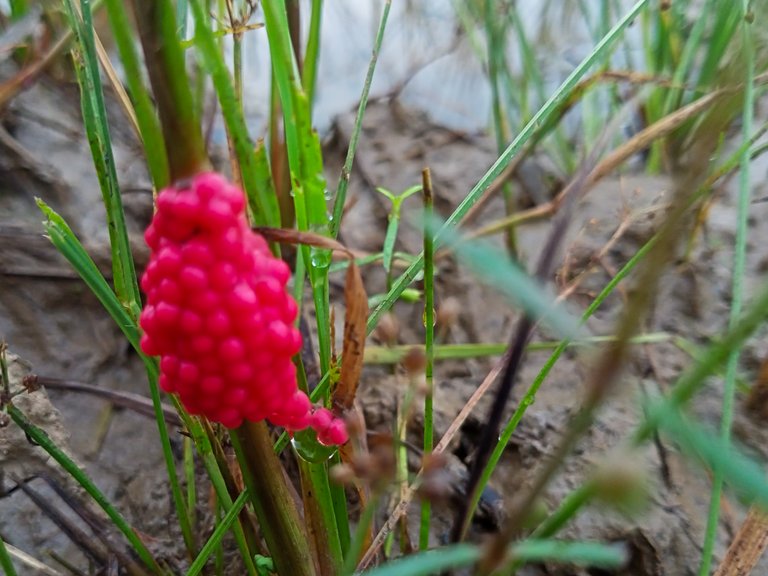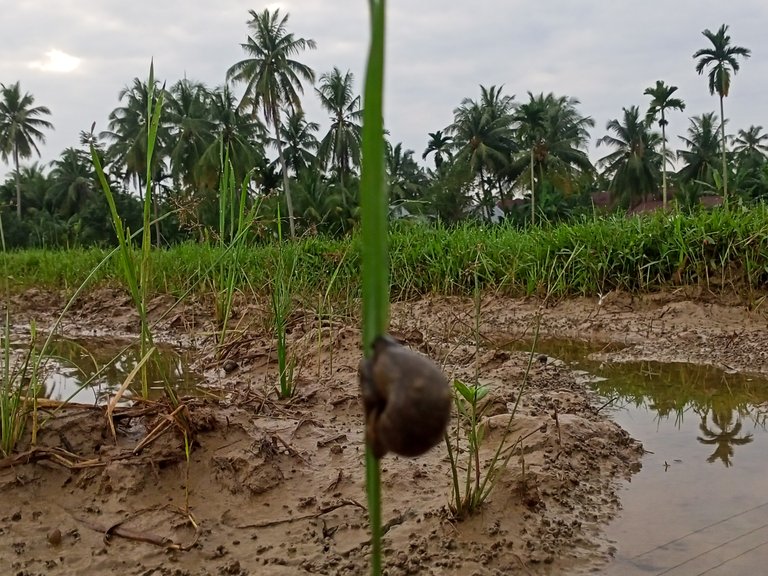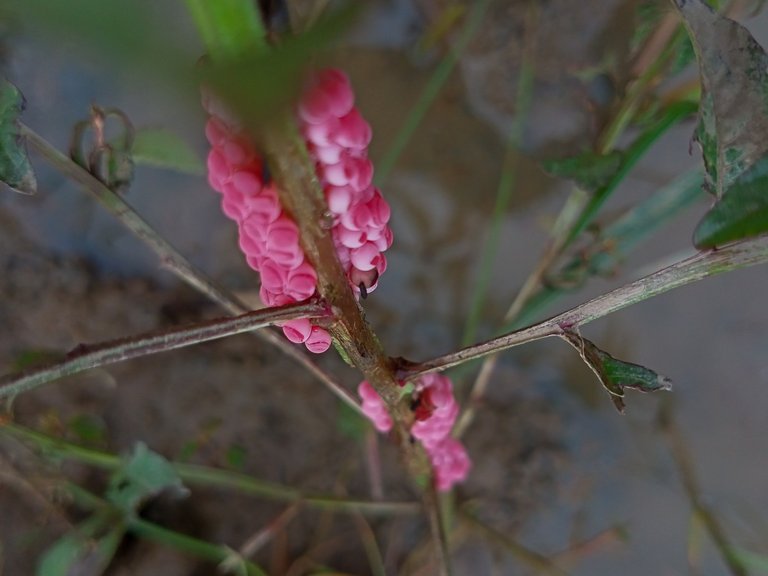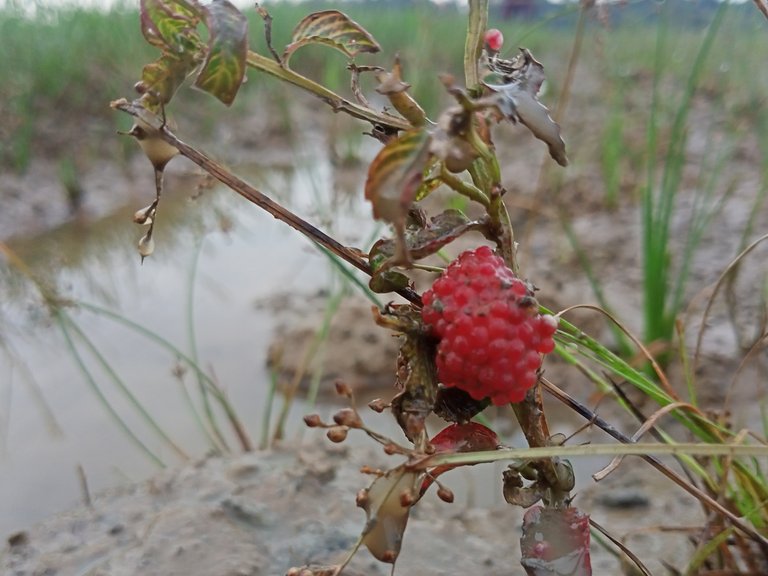Freshwater snails, or snails that live in rice fields. With the existence of the insole, the aquatic gastropods modules in Ampullariidae, most people in the Malay Archipelago call it Keong Mas.
this is due to the golden color of the shell and its shape that resembles a golden snail. Mas snails are found in rice fields and freshwater ponds.
Until now, the population of golden snails is difficult to control. Its herbivore nature is often considered a pest to rice plants in the fields where it lives.
This type of snail with a relatively fast population growth is quite disturbing aspects of agriculture and fisheries in Indonesia.
Golden snails are also able to adapt to various environmental conditions and are able to compete with other types of snails and local plants.
(But behind the assumption that lowland pests can also become poultry feed and shrimp feed, this is often used by duck layers and shrimp farmers in Aceh)
Gold snails are amphibians, because they have two means of breathing, namely gills and organs that resemble lungs. When in water, snails breathe with their gills and when on land use their lungs.
The air space is connected to the air above the water surface through a chiffon cloth formed by the mantle. The gills get oxygen from the water flowing through the mantle cavity and the lungs.
(conch eggs on rice stalks almost hatch)

(golden apple snail stick to rice stalks, perhaps one way they lay their eggs)










Italic# Please take a look BIBLIOGRAPHY
Andrews, E.B.1964.The Functional Anatomy and Histology of The Reproductive System of some Pilid Gastropod Molluscs.Proceeding of The Malacological Society of London. Vol.36.Blackwell Scientific Publications.Oxford.London.
Berry, A.J.1974.The Anatomy at Malaysian Snail of Parasitology Significance. Malay Nat.
Brahmanandam,V.Land R.V. Krishnamoorthy.1973.Hemochemistry and Hematology of Aestivating pond snail Pila globosa Veliger 24.16 (2):176-180
Esetebet,A.L and Martin,P.R. 2002.Pomacea canaliculata (Gastropoda: Ampularidae):Life History Traits and Their Plasticity. Mini Review.Workshop: Biology of Ampularidae.Biocell 26 (1);83-89
Hatimah S.W and Ismail.1989. Preliminary Research on Golden Snail (Pomacea sp)Cultivation of Inland Fisheries Research Bulletin. Vol.8 No.1 Freshwater Fisheries Research Institute.Bogor.
Hyman, L.H.1967.The Invertebrates. Vol.6. Mc-Grawhill Book Company. New York.
Joshi,R.C. 2005.Managing invasive alien mollusc species in rice. Mini Review. International Rice Research Notes.International Rice Research Institute.December.
Joshi RC, MS Dela Cruz, AR Martin, JC Cabbigat, RF Bahatan, AD Bahatan, J Choy-Awon, NP Chilagan, and AB Cayong. 2001. Current status of golden apple snail in the Ifugao Rice Terraces, Philippines. Journal of Sustainable Agriculture, USA. (in press)
Krupanidhi,S.M.Venugopal Reddy,V. Venleata Reddy & Padmanabha Naidhu. 1978.Purified Haemocyanin in The Blood of Fresh Water Amphibius Snail Pila globosa(Swainson)inrelation to Aestivation.Proc.Indian Acad.Sci.
http://www.apllesnail.net
Maclary, Andrew. 1965. Surface Inspiration and Ciliary Feeding in Pomacea paludosa (Prosobranchia): Mesogastropod: Ampularidae. Malacolagia)
Mardyanti. H. 1990. Protein Rich Golden Snail. Sinar Tani. No. 1963
Meenakshi V.R. 1956. Physiology of Hibernation of The Apple Snail Pila virent (lamarck). Current Science 25 (10).
Marwoto, R.M. 1988. The Occurrence Inspiratin of Freshwater Snail Pomacea sp. In Indonesia. Treubia. Vol.29 No.4
Murthy C.H, J.Pavan Kumar, K.S. Babu, Karumuri S.S.1979.On The Possible Significance of Anhanced Glutamate Dehydrogenase Activity in Normal and Aestivated Pila globosa. The Velliger Vol. 4
Noordin, H. 1992. Study of Growth and Reproduction Aspects of Mulberry Snails (Pomacea sp). Essay. Faculty of Fisheries. Bogor Agricultural Institute.Bogor.
Pennak, R.W. 1978.Fresh Water Invertebrates of The Unied States. Second Edition. John Wiley an Sons. New York. Chichester. Brisbane. Toronto.
Pitojo, S. 1996. Guidelines for the Control and Utilization of MAs Snails. Publisher Trubus Agriwidya. Ungaran
Prashad, B. 1925. Anatomy of The Common Apple Snail P.globosa. Memoir of The Inian Museum.
Purchon, R.D. 1978. The Biology of Mollusca. Pergamon Press. Oxford. New York.Toronto.Sydney.Paris.
Riani E. 1992. Some Biological Aspects of Mulberry Snails (Pomacea sp). Thesis. Postgraduate Faculty. Bogor Agricultural Institute. Bogor.
Santos, E.J. 1987. The Golden Apple Snail; Food and Farm Pest. Agribusiness Weekly. October.
Sihombing, D.T.H. 1999. Satwa Harapan I, Introduction to Cultivation Science and Technology, First Edition, Young Entrepreneur Library Publisher, Bogor
Soenarjo, E. Panuju and M. Syam. 1989. Cultivation of Mas Snail and Its Possible Impact on Rice Cultivation. Survey Results Report in West Java Province and Yogyakarta Special Province. Food Crops Research Institute. Bogor.
Sulistio.2006.Keong Mas,the rice destroyer. Pikiran Rakyat Print Edition Thursday, 19 April 2007.
Suwarman, P. 1989. Golden Snail Cultivation. Media Mina. No. 17. July 1989.
Takeda, N. 2000. Development of a Penis from The Vestigial Penis in The Female Apple Snail, Pomacea canaliculata. Bio Bull 199: 316 - 320
Wilbur K.L.and Gareth Owen. 1966. Growth. In C.M. Younge and Karl M Wilbur, ed. Physiology of Mollusca. Mc. Graw Hill. New York.











HTTP is in use instead of HTTPS and no protocol redirection is in place. Be careful and do not enter sensitive information in that website as your data won't be encrypted.
It's also a good habit to always hover links before clicking them in order to see the actual link in the bottom-left corner of your browser.
This auto-reply is throttled 1/20 to reduce spam but if it still bothers you reply "OFF HTTP". Or reply REVIEW for manual review and whitelisting.
Sorry for the mistakes I didn't understand .. And next time I'll be careful. @keys-defender Should I delete it ...
That link seems broken, maybe a typo?
The place is so
Congratulations @aquaculture! You have completed the following achievement on the Hive blockchain and have been rewarded with new badge(s) :
You can view your badges on your board and compare yourself to others in the Ranking
If you no longer want to receive notifications, reply to this comment with the word
STOPDo not miss the last post from @hivebuzz: